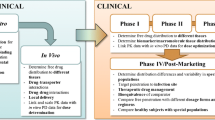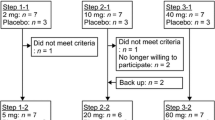Abstract
Purpose. The purpose of this study was to develop and validate an animal model of drug disposition in synovial fluid (SF) by comparing microdialysis with arthrocentesis using the anti-arthritic drug methotrexate (MTX).
Methods. Microdialysis probes were calibrated in vitro with the no net flux method using dog synovial fluid. The probes were implanted surgically into the stifle joint space of four dogs and were dialyzed overnight using a portable microinfusion pump. The membrane integrity of the probes was monitored by retrodialysis using an internal standard. After an intravenous bolus of 2.5 mg/kg of MTX, unbound concentrations in synovial fluid, as well as total plasma concentrations, were measured by liquid chromatography tandam mass spectrometer (LC/MS/MS) in samples collected from 0 to 48 h postdose.
Results. The probe membrane remained intact at least 48 h after implantation. The mean probe recovery and unbound fraction of MTX in SF were 46.8% and 44.8%, respectively. The unbound fraction of MTX was 44% in synovial fluid. MTX penetrated into the joint space rapidly, with maximal concentrations of 6.6 μM reached at approximately 1 h postdose. The unbound MTX area under the curve in SF was approximately 40% of the total area under the curve in plasma. These data agree well with the previous data obtained for MTX using arthrocentesis.
Conclusion. In contrast with arthrocentesis, microdialysis enables the collection of multiple serial SF samples from individual animals with minimal trauma and potential blood contamination. This animal model should prove valuable for studying the disposition of new anti-arthritis compounds or biomarkers in SF.
Similar content being viewed by others
REFERENCES
H. Benveniste and P. C. Huttemeier. Microdialysis-theory and application. Prog. Neurobiol. 35:195-215 (1990).
M. I. Davies and C. E. Lunte. Microdialysis sampling for hepatic metabolism studies. Impact of microdialysis probe design and implantation technique on liver tissue. Drug Metab. Dispos. 23:1072-1079 (1995).
J. Chu and J. M. Gallo. Application of microdialysis to characterize drug disposition in tumors. Ad. Drug Deliv. Rev. 45:243-252 (2000).
K. D. Rittenhouse and G. M. Pollack. Microdialysis and drug delivery to the eye. Ad. Drug Deliv. Rev. 45:229-241 (2000)
R. L. St. Claire III and K. R. Brouwer. Chemical analysis of bis(5-amidino-2-benzimidazolyl) methane in the arthritic rat knee using microdialysis and microcolumn liquid chromatography. J. Microcol. Sep. 3:531-537 (1991).
G. W. Lu, H. W. Jun, M. T. Dzimianski, H. C. Qiu, and J. W. McCall. Pharmacokinetic studies of methotrexate in plasma and synovial fluid following I.V. bolus and topical routes of administration in dogs. Pharm. Res. 12:1474-1477 (1995).
J.-W. Duan. C. Lihua, Z. Lu, Z. Wassermen, T. Maduskie, R-Q Liu, M. B. Covington, K. Vaddi, M. Qian, M. Voss, C-B Xue, K. D. Hardman, M. D. Ribadeneira, R. C. Newton, R. L. Magolda, D. D. Christ, and C. P. Decico. Discovery of selective and orally bioavailable TACE inhibitors. 2002 ACS Meeting, 618277.
L Stahle. On mathematical models of microdialysis: geometry, steady-state models, recovery and probe radius. Adv. Drug. Deliv. Rev. 45:149-167, 2000.
S. Menacherry, W. Hubert, and J. B. Justice Jr. In vivo calibration of microdialysis probes for exogenous compounds. Anal. Chem. 64:577-583 (1992).
S. Herrera, D. O. Scott, and C. E. Lunte. Microdialysis sampling for determination of plasma protein binding of drugs. Pharm. Res. 10:1077-1081 (1990).
J.-T. Wu, H. Zeng, M. Qian, B. Brogdon, and S. E. Unger. Direct plasma sample injection in multiple-component LC-MS-MS assays for high-throughput pharmacokinetic screening. Anal. Chem. 72:61-67 (2000).
W. F. Elmquist, K. K. H. Chan, and R. J. Sawchuck. Transsynovial drug distribution: synovial mean transit time of diclofenac and other nonsteroidal antiinflammatory drugs. Pharm. Res. 11:1689-1697 (1994).
Y. Wang, S. L. Wong, and R. J. Sawchuck. Microdialysis calibration using retrodialysis and zero-net flux: aplication to a study of the distribution of zidovudine to rabbit cerebrospinal fluid and thalamus. Pharm. Res. 10:1411-1419 (1993).
M. B. DeSousa Maia, S. Saivin, E. Chatelut, M. F. Malmary, and G. Houin. In vitro and in vivo protein binding of methotrexate assessed by microdialysis. Int. J. Clin. Pharmacol. Ther. 34:335-341 (1996).
R. O. Day, A. J. McLachlan, G. G. Graham, and K. M. Williams. Pharmacokinetics of nonsteroidal anti-inflammatory drugs in synovial fluid. Clin. Pharmacokinet. 36:191-210 (1999).
W. J. Wallis and P. A. Simpkins. Antirheumatic drug concentrations in human synovial fluid and synovial tissue. Observations on extravascular pharmacokinetics. Clin. Pharmacokinet. 8:496-522 (1983).
Author information
Authors and Affiliations
Corresponding author
Rights and permissions
About this article
Cite this article
Qian, M., West, W., Wu, JT. et al. Development of a Dog Microdialysis Model for Determining Synovial Fluid Pharmacokinetics of Anti-Arthritis Compounds Exemplified by Methotrexate. Pharm Res 20, 605–610 (2003). https://doi.org/10.1023/A:1023246832321
Issue Date:
DOI: https://doi.org/10.1023/A:1023246832321




